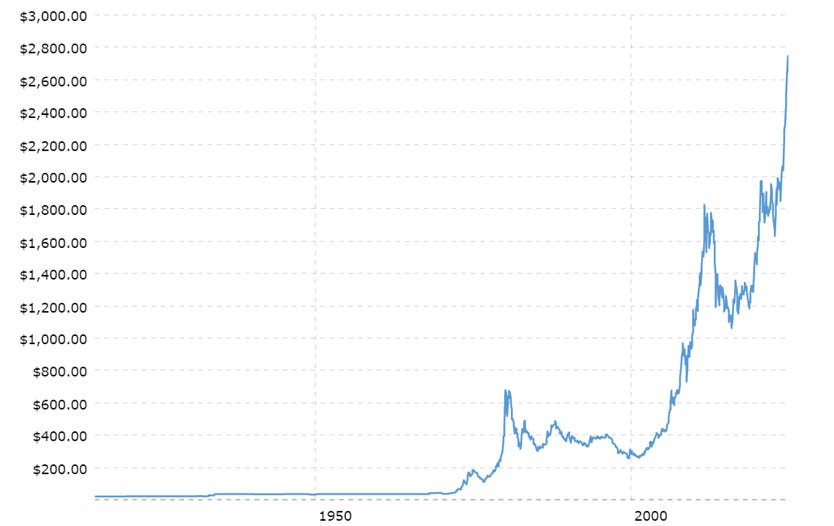Legendary investor Jim Rogers keeps buying silver. As per Jim Rogers:
“Everybody should own gold and silver. If I were buying one today, I would buy silver because it's cheaper.”
See his recent interview below. Jim Rogers has been talking about buying silver at least since 2022, when it was around $20 per ounce. Currently, it is trading at around $30 per ounce, well below its all-time historic high of about $50 per ounce.
As rising prices continue to be an issue, many people are looking for a safe haven for their savings. Commodities are generally considered safe havens, including old-time classics like gold and silver. What makes silver so compelling is that it is still trading at a significant discount vs. its historic high, whereas gold just reached its new historic high. Both will most likely continue to appreciate, but at the current price level, the upside potential for silver seems much higher, as per Rogers.
The Current Landscape: Gold vs. Silver
Gold has recently surged to new historic highs, trading at around $2,800 per ounce as of late 2024. Great if you purchased gold earlier, and it will most likely go up further long-term. Compared to silver, though, if you buy gold today, you're buying at or close to the all-time historical high.
Historical Gold Price in US Dollars
Source: https://www.macrotrends.net/1333/historical-gold-prices-100-year-chart
Silver, by comparison, is still trading well below its historical high of around $50 per ounce.
Historical Silver Price in US Dollars
Source: https://www.macrotrends.net/1470/historical-silver-prices-100-year-chart
Both gold and silver functioned historically as a hedge against inflation to protect against losing purchasing power. In a perfect market, gold and silver would behave similarly. And in the long term, they most likely will. As per Jim Rogers, however, in the short term, currently silver is much cheaper than gold compared to historical highs and thus a better buying opportunity than gold. But it isn’t just the relatively low silver price that is compelling; there is more to it, namely the gold-silver ratio.
The Gold-Silver Ratio
The gold-silver ratio is a crucial metric for investors in precious metals, representing the number of ounces of silver required to purchase one ounce of gold. Historically, the gold-silver ratio has varied significantly.
For instance, during the Roman Empire, the ratio was approximately 12:1, indicating that 12 ounces of silver could buy one ounce of gold.
More recently, the long-term average ratio was about 60:1.
That ratio reached an all-time high of over 110 in April 2020 amid the COVID-19 pandemic.
As of late 2024, the ratio hovers around 86:1, further suggesting that silver is currently undervalued compared to gold.
Historical Gold Silver Ratio
Source: https://www.macrotrends.net/1441/gold-to-silver-ratio
At the beginning of the article, I mentioned briefly what Jim Rogers said. Let’s go a bit deeper on his insights.
Insights from Legendary Investor Jim Rogers: Load Up on Silver
Among the legendary investors, Jim Rogers is interesting in that his focus is mainly on commodities and international. He is a US citizen, has been living in Singapore for a long time, and is heavily invested in China, India, gold, silver, and other commodities.
Currently, he is just investing his own considerable wealth, and to my knowledge, he is not selling anything or accepting any 3rd party investor money. But what he does do so generously is share his considerable knowledge through YouTube and print interviews.
In a recent interview (see link below—start at time code 21:44), Jim Rogers mentioned that he is buying silver right now. Silver, but not gold, because gold is at an all-time high, whereas silver's still down a lot from its all-time high.
As per Rogers, he prefers to buy the one that's cheaper on a historic basis. Rogers then went on to explain how long silver has been used as currency. As Rogers put it, Jesus Christ was sold for 30 pieces of silver, not for 30 pieces of gold, because silver was the store of value in those days.
Source:
Jim Rogers makes similar arguments in different interviews. He argues that when prices are down—like silver is now compared to its historical peaks—it’s time to buy. Rogers believes that owning real assets such as silver provides a hedge against inflation and economic uncertainty. Rogers maintains that while he continues to hold gold, he sees greater potential for appreciation in silver due to its current undervaluation. His perspective resonates with many seasoned investors who recognize that silver's price could rebound significantly as market conditions shift.
Knowing the potential of silver, the next question is – how best to invest in silver.
Silver—How to Invest?
Physical silver is best. If you are not moving around different countries and have a safe place to store it, physical silver is best. As the old legal maxim goes, possession is 9/10ths of the law. This legal principle emphasizes the importance of physical possession in establishing ownership rights.
Essentially, it suggests that having something in your possession gives you a stronger claim to it than someone who merely asserts ownership without physical control. Thus, physical silver is best.
The next best alternative, other than silver miners, are paper alternatives like exchange-traded funds (ETFs) backed by silver. While paper options offer liquidity and convenience, they come with inherent risks. If the silver collateral is not there, all you have is paper but no silver or not enough silver. Two very popular paper silver ETFs are iShares Silver Trust (SLV) and Sprott Physical Silver Trust (PSLV).
Many investors, me included, prefer PSLV as the safer alternative in terms of silver actually being there. I am not saying that there is something wrong with SLV, but the silver storage for PSLV is superior in my opinion.
In specific, the collateral consists of unencumbered and fully allocated silver bars. These physical silver bars are stored securely by the Royal Canadian Mint (RCM), which acts as the custodian for the trust's assets. PSLV does not seem to allow silver lending.
RCM, as a Crown corporation, provides a trustworthy environment, conducting regular audits to maintain transparency. A Crown corporation in Canada is a government-owned entity that operates with a blend of commercial and public policy objectives. In the event of theft or loss of these assets, the RCM has an obligation to compensate for such losses, ensuring that the trust's holdings remain intact.
For more information on investing in these 2 ETFs, read my other recent article on investing in silver, “The Silver Surge: Investing in Physical Silver ETFs.”
Conclusion: Seize the Opportunity
As we navigate an increasingly uncertain economic landscape marked by inflationary pressures, investing in silver presents a strategic opportunity for diversification and potential growth.
The current undervaluation of silver compared to gold, coupled with insights from experts like Jim Rogers, reinforces the notion that now may be the perfect time to consider adding this precious metal to your investment portfolio.
Thank you for reading the article. Hope you enjoyed it.
Hungry for more? Subscribe to the newsletter - it's free and fabulous.Enjoyed this article? Don't keep it to yourself! Share it with a friend or two. It's free, and they might even buy you a coffee as a thank you.Your Fringe Finance
Disclaimer
Neither the author nor Fringe Finance is a financial advisor or a tax professional. This article is for illustrative and educational purposes only and does not constitute a specific offer of any product or service.
Past performance of stocks and assets is not an indicator or guarantee of future performance of stocks and assets.
The information in this blog does not constitute an offer to buy or sell, or a solicitation of an offer to buy or sell, any of the securities mentioned herein.
We believe the information provided is accurate and current. However, we do not guarantee its accuracy and it should not be considered a complete analysis of the topics discussed.
Any opinions expressed reflect the author's judgment at the time of publication and are subject to change.
Seek guidance from qualified financial and tax experts before taking action.










This is good news
Been holding gold and silver since 2023. Can’t complain about the returns so far.